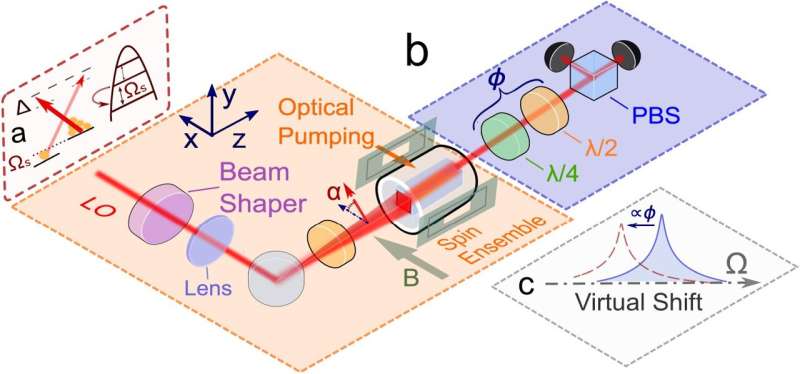This article has been reviewed according to Science X's editorial process and policies. Editors have highlighted the following attributes while ensuring the content's credibility:
fact-checked
peer-reviewed publication
trusted source
proofread
Research overcomes major obstacle for quantum sensor development

Researchers from the Niels Bohr Institute (NBI) have removed a key obstacle for development of extremely sensitive monitoring devices based on quantum technology.
Monitoring the heartbeat of an unborn child and other types of delicate medical examinations show the potential of quantum sensors. Since these sensors exploit phenomena at the scale of atoms, they can be far more accurate than today's sensors.
Researchers from the Niels Bohr Institute (NBI), University of Copenhagen, have managed to overcome a major obstacle for development of quantum sensors. Their results are published in Nature Communications.
All life processes involve tiny variations in magnetic fields and tissue conductivity. Quantum sensors can detect these extremely small variations. However, a key challenge is to distinguish the signals of interest from various types of noise. It is this problem which the NBI group has contributed to solve.
"Quantum sensors have become one of the first applications of nanotechnology. Our findings bring these sensors closer to applications. I expect we will see the first practical implementations in a couple of years," says Professor at NBI Eugene Polzik, lead author on the scientific article.
Besides heart anomaly, several other possible abnormalities may be surveyed. All, while the patient rests undisturbed. Many other examinations such as brain monitoring can be made possible or improved by quantum sensors.
Hearing the noise from the quantum world
The behaviors of atoms, electrons, and photons are described by quantum mechanics. The particles do not only have given physical properties, but also exist in certain states. The quantum sensing method starts by preparing quantum states of light to be used to read a signal. The quantum state of light is sent to interact with a probe quantum system that is affected by the forces or fields that one wants to detect. After the interaction, light carries the information on the measured quantity and can be detected with high accuracy.
"The engineering of the quantum probe system must be tailormade to fit the signal of interest. This is one of the main challenges for quantum sensing, since it is hard to eliminate unwanted noise completely," Polzik explains.
Even after traditional sources of noise—such as electronic equipment in the room etc.—have been eliminated, the effects of quantum mechanics will remain. Unlike in traditional physics, quantum mechanics will give the quantum state and other properties of a particle as a probability function, or uncertainty if you will.
One source of quantum noise is the uncertainty associated with the arrival of light particles (photons) at the detector. This is known as shot noise.
Further, as photons transfer their momentum to the probe sensor, the act of the interaction itself is also a source of quantum noise. This is known as quantum backaction.
In their scientific article, the team demonstrates a method to "hear" the noise coming from the quantum world, thereby allowing it to be removed so the real signal of interest remains.
Future application in astrophysics
Besides for medical examinations, magnetic quantum sensors may find applications in a range of other fields. One example is gravitational wave detection. Originally described theoretically by Albert Einstein, the existence of cosmic gravitational waves is well established.
However, since the signature of gravitational waves is weak in relation to other types of cosmic signals, existing methods for gravitational wave monitoring need improvement.
Magnetic quantum sensors combined with gravitational wave antennas might well be an answer to the challenge of monitoring gravitational waves, and thereby contribute to a deeper understanding of the origin and development of the universe.
More information: Jun Jia et al, Acoustic frequency atomic spin oscillator in the quantum regime, Nature Communications (2023). DOI: 10.1038/s41467-023-42059-y
Journal information: Nature Communications
Provided by Niels Bohr Institute



















